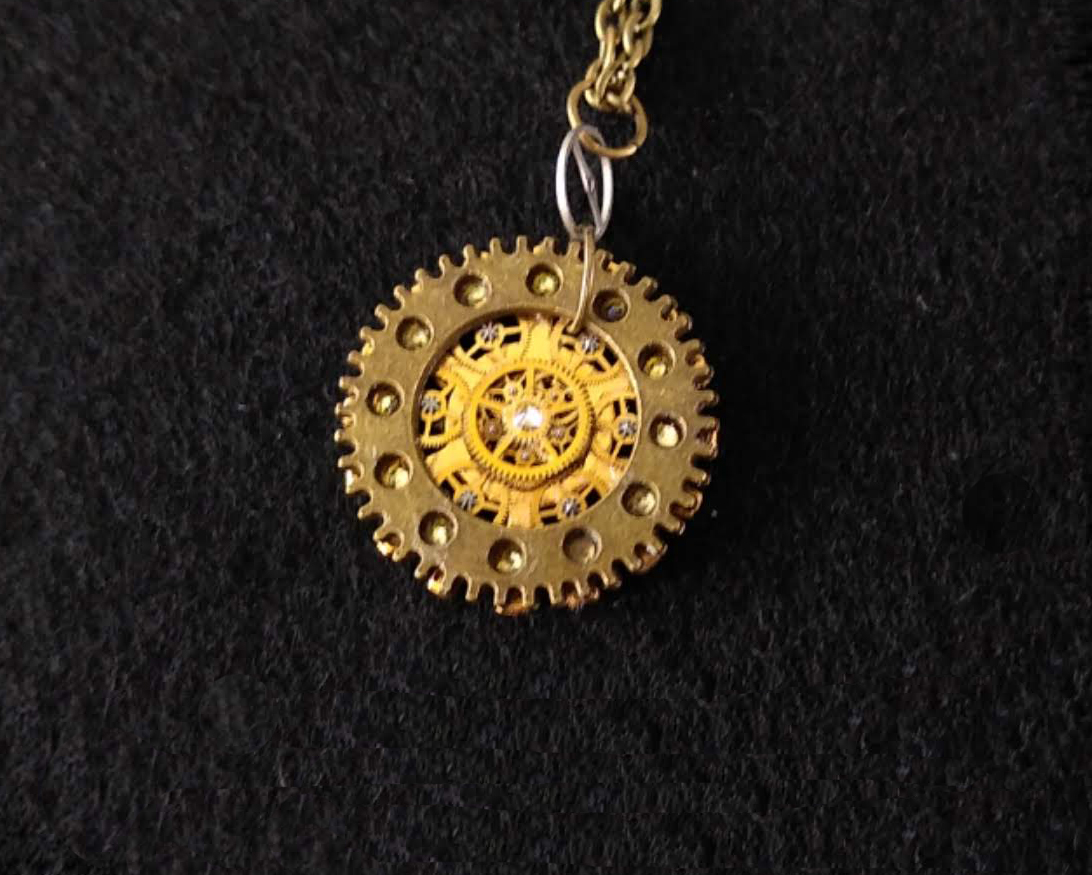

Steampunk Filigree
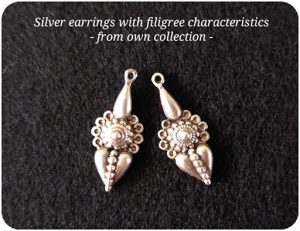 Filigree is a delicate and lacelike kind of jewellery metalwork. Fine, pliable metal threads are curled, twisted or plaited in ornamental and intertwined patterns, soldered together at points of contact or with the metal groundwork. Usually metals such as gold and silver are used in the filigree techniques, although other materials are sometimes used, such as copper wire or wood. Tiny beads or twisted threads or a combination of both are soldered together or on to the surface of an object of the same metal. They are arranged in beautiful and artistic motifs and patterns. When you look for the definition of the word “filigree“, the noun is explained in www.dictionary.com as: 1. Delicate ornamental work of fine silver, gold or other metal wires, especially lacy jewellers’ work of scrolls and arabesques; 2. anything very delicate or fanciful (“a filigree of frost”).
Filigree is a delicate and lacelike kind of jewellery metalwork. Fine, pliable metal threads are curled, twisted or plaited in ornamental and intertwined patterns, soldered together at points of contact or with the metal groundwork. Usually metals such as gold and silver are used in the filigree techniques, although other materials are sometimes used, such as copper wire or wood. Tiny beads or twisted threads or a combination of both are soldered together or on to the surface of an object of the same metal. They are arranged in beautiful and artistic motifs and patterns. When you look for the definition of the word “filigree“, the noun is explained in www.dictionary.com as: 1. Delicate ornamental work of fine silver, gold or other metal wires, especially lacy jewellers’ work of scrolls and arabesques; 2. anything very delicate or fanciful (“a filigree of frost”).
 Filigree is not the same as ajouré jewellery work, in which style of jewellery the techniques consists of drilling or cutting holes in objects made of sheet metal, thus leaving open spaces in the worked metal. The result of ajouré jewellery making is reminiscent of the style of lace that is known as “ajour”, but with a different used technique than in filigree. Filigree, however, does have a connection to granulated metalwork. Granulation is a jewellery manufacturing technique in which a metal surface is covered in many little spherules or granules of precious metals, which are soldered to form patterns. Archaeologists belief that it has its origin in Sumer about 5000 years ago and it was used often by Mesopotamian craftsmen.
Filigree is not the same as ajouré jewellery work, in which style of jewellery the techniques consists of drilling or cutting holes in objects made of sheet metal, thus leaving open spaces in the worked metal. The result of ajouré jewellery making is reminiscent of the style of lace that is known as “ajour”, but with a different used technique than in filigree. Filigree, however, does have a connection to granulated metalwork. Granulation is a jewellery manufacturing technique in which a metal surface is covered in many little spherules or granules of precious metals, which are soldered to form patterns. Archaeologists belief that it has its origin in Sumer about 5000 years ago and it was used often by Mesopotamian craftsmen.
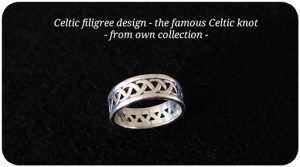 The word “filigree” used to be written as “filigrain” or “filigrene“. Today sometimes it is also spelled as “filagree“. Filigree is the shortened version of an earlier form of “filigreen” (1660s), which derives from the Latin words “filum”, meaning thread, and “granum”, meaning grain as of a small bead. The Latin word became “filigrana” in Italy during medieval times and transformed in seventeenth century France to “filigrane“. Though filigree has become a special branch of jewellery crafting in modern times, it was historically part of the ordinary work of a jeweller.
The word “filigree” used to be written as “filigrain” or “filigrene“. Today sometimes it is also spelled as “filagree“. Filigree is the shortened version of an earlier form of “filigreen” (1660s), which derives from the Latin words “filum”, meaning thread, and “granum”, meaning grain as of a small bead. The Latin word became “filigrana” in Italy during medieval times and transformed in seventeenth century France to “filigrane“. Though filigree has become a special branch of jewellery crafting in modern times, it was historically part of the ordinary work of a jeweller.
Filigree metalwork has been found from Africa to Asia and archaeologists have excavated jewellery with incorporated filigree dating back to ancient Mesopotamia of 3000 BC. Patterns of gold ground have been derived in ornaments from Phoenician sites, such as in Cyprus and Sardinia, but the filigree artwork became really advanced to a very high perfection by the Greeks and Etruscans during the 6th-3rd centuries BC. These civilizations made all their jewellery by soldering gold together rather than by chiselling or engraving materials.
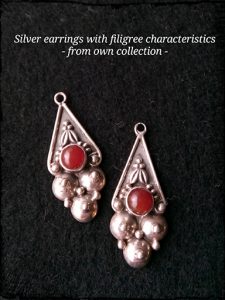 It is not known whether Asiatic jewellers were influenced by the Greeks who settled on the Asian continent or if they trained under common traditions, but it is certain that Indian filigree workers retained the same patterns as the ancient Greek filigree workers had and that they worked them in the same way. Filigree has been and still is quite popular in Indian and other Asian designs of metalwork, both jewellery and otherwise. It has been worked for a very long time without any change in the designs.
It is not known whether Asiatic jewellers were influenced by the Greeks who settled on the Asian continent or if they trained under common traditions, but it is certain that Indian filigree workers retained the same patterns as the ancient Greek filigree workers had and that they worked them in the same way. Filigree has been and still is quite popular in Indian and other Asian designs of metalwork, both jewellery and otherwise. It has been worked for a very long time without any change in the designs.
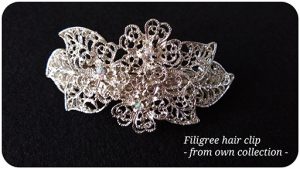 Much of the medieval metalwork all over Europe dating back to the 15th century, not just jewellery but also reliquaries, crosses and other goldsmith’s work, is set off with bosses and borders of filigree. Many of these pieces were made either in Constantinople (from the 6th-12th century AD) or in European monasteries, which studied and imitated Byzantine goldsmiths’ art and craftwork. Also the Saxons, the Britons and the Celts in the north of Europe were very skilful in several kinds of filigree goldsmiths’ work from an early period. The Insular Period was a time of close cultural interaction between Britain and Ireland from around 550-900AD. Irish filigree metalwork dating back to this time shows increasingly complicated designs and more extremely varied patterns with curious and interesting knots. Its highest perfection in thoughtful designs is found in filigree work from the 10th and 11th centuries. Their remarkable and beautiful fine patterns are well known and have been copied and imitated for centuries after, even today, such as the famous Tara brooch, a Celtic brooch that is dated between 650 and 750AD and was found in Ireland in 1850.
Much of the medieval metalwork all over Europe dating back to the 15th century, not just jewellery but also reliquaries, crosses and other goldsmith’s work, is set off with bosses and borders of filigree. Many of these pieces were made either in Constantinople (from the 6th-12th century AD) or in European monasteries, which studied and imitated Byzantine goldsmiths’ art and craftwork. Also the Saxons, the Britons and the Celts in the north of Europe were very skilful in several kinds of filigree goldsmiths’ work from an early period. The Insular Period was a time of close cultural interaction between Britain and Ireland from around 550-900AD. Irish filigree metalwork dating back to this time shows increasingly complicated designs and more extremely varied patterns with curious and interesting knots. Its highest perfection in thoughtful designs is found in filigree work from the 10th and 11th centuries. Their remarkable and beautiful fine patterns are well known and have been copied and imitated for centuries after, even today, such as the famous Tara brooch, a Celtic brooch that is dated between 650 and 750AD and was found in Ireland in 1850.
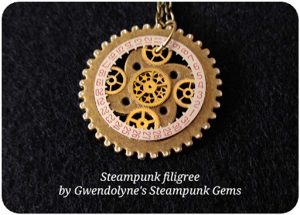 The oldest filigree items that have been discovered on the Iberian peninsula date back to 2000-2500BC, although archaeologists have doubts whether these jewellery pieces were really created here or that they have their origin in the Middle East and were brought here by travellers from those areas. With the arrival of Arab migrants in the 8th century in Portugal, filigree really started to be produced in these areas. The new Arab migrants brought new filigree patterns with them, but while in Spain the filigree jewellery making became less relevant, in Portugal it was perfected with different patterns. After the 18th century Portuguese filigree had its own particular and distinctive imagery, motifs and shapes. Portuguese filigree from the 17th and 18th centuries became even famous for its extraordinary and distinctive complexity.
The oldest filigree items that have been discovered on the Iberian peninsula date back to 2000-2500BC, although archaeologists have doubts whether these jewellery pieces were really created here or that they have their origin in the Middle East and were brought here by travellers from those areas. With the arrival of Arab migrants in the 8th century in Portugal, filigree really started to be produced in these areas. The new Arab migrants brought new filigree patterns with them, but while in Spain the filigree jewellery making became less relevant, in Portugal it was perfected with different patterns. After the 18th century Portuguese filigree had its own particular and distinctive imagery, motifs and shapes. Portuguese filigree from the 17th and 18th centuries became even famous for its extraordinary and distinctive complexity.
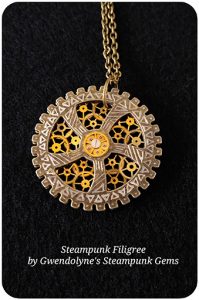 Modern filigree jewellery is often surrounded and subdivided by bands of square or flat metal, which gives consistency to the filling up, that would otherwise lose its proper shape. Although the designs of Gwendolyne’s Steampunk Gems are not proper filigree metalwork when sticking to the definition of how filigree is created normally, the jewellery pieces of Gwendolyne’s Steampunk Gems appear to have that sort of style. The shapes of the cogs and gears and the way how they are forged together in mesmerizing and twisted patterns, give the impression of historical filigree motifs. The synchronism of the way how the cogs and gears are placed and linked up in certain shapes reminds of filigree art, with its curling, twisting and plaiting threads of metalwork. That is what I personally like to refer to as “Steampunk Filigree”.
Modern filigree jewellery is often surrounded and subdivided by bands of square or flat metal, which gives consistency to the filling up, that would otherwise lose its proper shape. Although the designs of Gwendolyne’s Steampunk Gems are not proper filigree metalwork when sticking to the definition of how filigree is created normally, the jewellery pieces of Gwendolyne’s Steampunk Gems appear to have that sort of style. The shapes of the cogs and gears and the way how they are forged together in mesmerizing and twisted patterns, give the impression of historical filigree motifs. The synchronism of the way how the cogs and gears are placed and linked up in certain shapes reminds of filigree art, with its curling, twisting and plaiting threads of metalwork. That is what I personally like to refer to as “Steampunk Filigree”.
Gwendolyne Blaney – GSG
References
Wikipedia – https://en.wikipedia.org/wiki/Filigree – “Filigree”
Wikipedia – https://en.wikipedia.org/wiki/Ajour – “Ajoure”
Encyclopædia Britannica – https://www.britannica.com/art – “Filigree; Decorative Art”
Wikisource – https://en.wikisource.org/wiki/1911_Encyclop%C3%A6dia_Britannica/Filigree – “1911 Encyclopædia Britannica/Filigree”
Etymonline – http://www.etymonline.com/word/filigree – “Filigree (n.)”
Dictionary.com – http://www.dictionary.com/browse/filigree – “Filigree”
